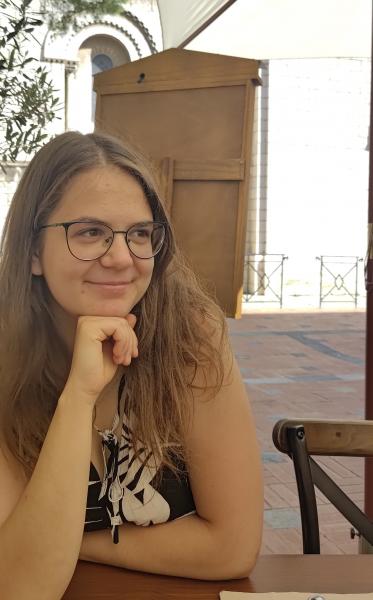
Contact
Email: vlakne0@student.bbk.ac.uk | ucbtve0@ucl.ac.uk
Centre for Brain and Cognitive Development
Department of Psychological Sciences
Birkbeck, University of London
University College London
Supervisors
I am currently doing rotations at the CBCD.
The primary supervisor for my first rotation is: Dr Ori Ossmy, ori.ossmy@bbk.ac.uk
The primary supervisor for my second rotation is: Prof Emily Jones, e.jones@bbk.ac.uk
Research interests
My research interests include cognitive development, socioeconomic effects and potential interventions. I completed my first rotation at the Physical Cognition Lab under the supervision of Dr Ori Ossmy and Dr Denis Mareschal. I worked on recreating and improving a computational model of the development of gaze following. In the meantime, I also observed ongoing data collection in the lab. I am currently finishing my second rotation with Prof Emily Jones, working on data they have collected before examining EEG recordings of 5-month-olds looking at visual stimuli. I am also helping Amy Lawson collect data for the OTTERS study, as part of her PhD.
Education
PhD Neuroscience (2021 - present)
Birkbeck, University of London
MSci Systems Biology (2021 – 2022)
University of Cambridge
BA Biological Natural Sciences (2018 – 2021)
University of Cambridge
Research Experience
(2023–2024) Visiting Researcher, PIPKIN, Babylab at the University of Cambridge
I assisted in adopting DeepLabCut for the annotations of 4D ultrasound recordings of foetuses to track their prenatal movements. I supported the supervision of the undergraduate student completing her research project in the group. I also participated in appointments for collecting data for the project, including 4D ultrasounds, home and lab visits.
(2023–2024) Research Volunteer, Isabelle Mareschal, Queen Mary University of London
I acquired pilot data for the group’s new facial expression generating software. The previous version generated facial expressions using avatars. This newer software uses real human faces of different gender and race. I collected consent and explained the study to the participants. I also took note of any issues and suggestions for the developers.
(2022–2023 ) Research Assistant, Isogai Lab, Sainsbury Wellcome Centre
I analysed mouse behavioural videos using DeepLabCut and manual annotation (Noldus, BORIS). I checked whether probe trajectories were correctly targeted for neural recordings (Brainglobe, AP histology pipeline). With the use of ImageJ I contributed to the output tracing analysis, which was part of the master’s student research project in the lab.
(2022–2022) Distance Learning Tutor, Psychology Course, Anglia Ruskin University
I held tutorial sessions and provided personal help for students in the statistics class.
(2021–2022) Master’s Research Project, Moyroud Lab, Sainsbury Laboratory
I worked on a mutant line of Hibiscus trionum, to characterise it genetically and phenotypically. For this I used qPCR, semi-qPCR, light microscopy with analysis in ImageJ and self-written script in R, confocal microscopy with analysis in MorphographX and MATLAB. I also worked on the creation of a knock-out line with the use of CRISPR-Cas9, and maintained tissue cultures under sterile conditions, performed gDNA extraction to send to sequencing.
(2021–2021) Research Volunteer, BRIGHT, Babylab, Birkbeck, University of London
I assisted in the BRIGHT project of the Babylab, processing data in Excel from their eye-tracking experiments with the “looking-while-listening” task with a custom-written Python code, reducing the amount of manual labour required. To have access to the data, I completed an online course in data protection and a GDPR training course, focusing on the ethical and confidential handling of participant information. I also learnt about challenges and appropriate adaptations when it comes to performing experiments across different cultures and socioeconomic backgrounds.
(2020–2021) Undergraduate Research Project, Prediction and Learning Lab, University of Cambridge
I wrote a grant proposal including a literature review and detailing the intended experiments for the project investigating free choice preference. Due to COVID-19 restrictions, I created a cognitive task using the Gorilla platform and collected the data remotely using Prolific to recruit participants. I analysed the data with SPSS.
(2020–2020) Research Intern, Computational Systems Neuroscience Lab, MTA Wigner Research Centre for Physics
I participated in the weekly meetings of Gergő Orbán’s group, the Computational Systems Neuroscience Lab, including the journal club. I learnt the foundations of computational neuroscience by following 'Theoretical Neuroscience' by Peter Dayan and L.F. Abbott. By the end, I produced a reinforcement learning program in Python (sklearn package) working on a public dataset of neural recordings of spikes when looking at bars of different angles. The program was able to determine the angle of the bar based on the spike pattern.
Publications
Edwards, M. D., Yin, Z., Sueda, R., Gubanova, A., Xu, C. S., Lakner, V., Murchie, M., Lee, C.-Y., Ng, K., Farrell, K., Faraway, R., Ganguly, S., Jacobs, E., Bogdan Bintu, & Yoh Isogai. (2024). Combined transcriptomic, connectivity, and activity profiling of the medial amygdala using highly amplified multiplex in situ hybridization (hamFISH). BioRxiv (Cold Spring Harbor Laboratory). https://doi.org/10.1101/2024.09.14.613026
Awards / Funding
PhD studentship: London Interdisciplinary Doctoral Programme (LIDo), funded by BBSRC and Birkbeck, University of London
